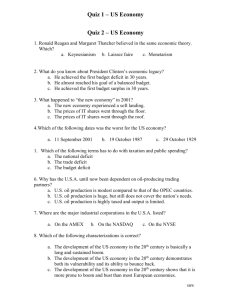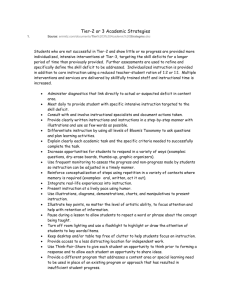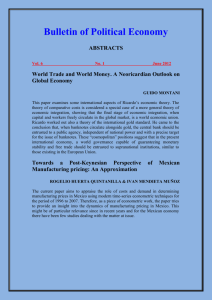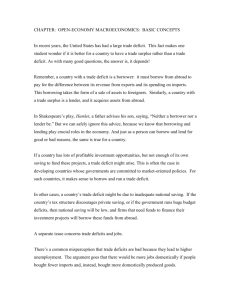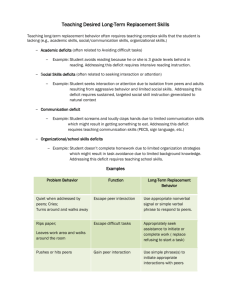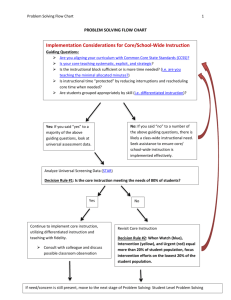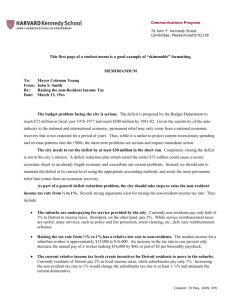Is The Large US Current Account Deficit Sustainable?
advertisement
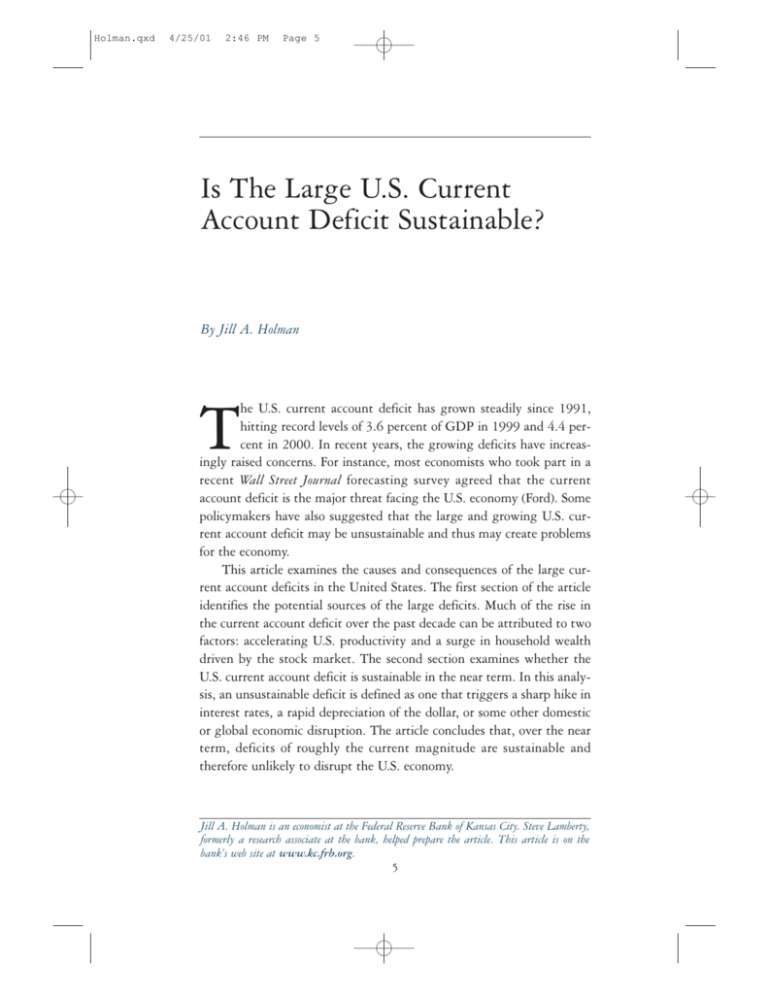
Holman.qxd 4/25/01 2:46 PM Page 5 Is The Large U.S. Current Account Deficit Sustainable? By Jill A. Holman T he U.S. current account deficit has grown steadily since 1991, hitting record levels of 3.6 percent of GDP in 1999 and 4.4 percent in 2000. In recent years, the growing deficits have increasingly raised concerns. For instance, most economists who took part in a recent Wall Street Journal forecasting survey agreed that the current account deficit is the major threat facing the U.S. economy (Ford). Some policymakers have also suggested that the large and growing U.S. current account deficit may be unsustainable and thus may create problems for the economy. This article examines the causes and consequences of the large current account deficits in the United States. The first section of the article identifies the potential sources of the large deficits. Much of the rise in the current account deficit over the past decade can be attributed to two factors: accelerating U.S. productivity and a surge in household wealth driven by the stock market. The second section examines whether the U.S. current account deficit is sustainable in the near term. In this analysis, an unsustainable deficit is defined as one that triggers a sharp hike in interest rates, a rapid depreciation of the dollar, or some other domestic or global economic disruption. The article concludes that, over the near term, deficits of roughly the current magnitude are sustainable and therefore unlikely to disrupt the U.S. economy. Jill A. Holman is an economist at the Federal Reserve Bank of Kansas City. Steve Lamberty, formerly a research associate at the bank, helped prepare the article. This article is on the bank’s web site at www.kc.frb.org. 5 Holman.qxd 4/25/01 6 2:46 PM Page 6 FEDERAL RESERVE BANK OF KANSAS CITY Chart 1 THE U.S. CURRENT ACCOUNT DEFICIT AS A SHARE OF GDP Percent 4.5 4.0 3.5 3.0 2.5 2.0 1.5 1.0 0.5 0.0 -0.5 1980 '81 '82 '83 '84 '85 '86 '87 '88 '89 1990 '91 '92 '93 '94 '95 '96 '97 '98 '99 2000 2000 Note: Figures are based on annual data for the current account deficit and GDP. Source: Bureau of Economic Analysis I. WHAT CAUSED THE DEFICITS OF THE 1990s? Explaining the rise in the current account deficit shown in Chart 1 requires considering a range of other variables.1 Many of these variables are part of the U.S. economy’s external sector: the trade account, international financial flows, and the exchange rate. Movements in the current account deficit are due primarily to movements in the trade deficit (box). The current account deficits are financed by net capital inflows from abroad. Finally, the exchange rate is related to the current account because international transactions (including trade in goods, services, and financial assets) generally require exchanging dollars for foreign currencies. Among the many different forces that affected the behavior of the U.S. external sector from 1990 to 2000, two factors are key. First, the rise in the U.S. current account deficit reflects a surge in investment spending caused by accelerating U.S. productivity.2 Second, the booming U.S. stock market in the 1990s enhanced household wealth and consumer spending, causing the deficit to widen further. In the last few Holman.qxd 4/25/01 2:46 PM Page 7 ECONOMIC REVIEW • FIRST QUARTER 2001 7 WHAT IS THE CURRENT ACCOUNT? A country’s international trade in goods and services and international borrowing and lending are recorded in its balance of payments accounts. The balance of payments consists of two main accounts: the current account and the financial account.† The current account measures the change over time in the sum of three separate components: the trade account, the income account, and the transfer account. The trade account measures the difference between the value of exports and imports of goods and services. A trade deficit occurs when a country imports more than it exports. The U.S. trade deficit is by far the largest component of the U.S. current account deficit. In fact, fluctuations in the trade deficit are the primary cause of fluctuations in the current account deficit. The income account measures the income payments made to foreigners net of income payments received from foreigners. For the United States, the income account largely reflects interest payments made by the United States on its foreign debt and interest payments received by the United States on its foreign assets. An income deficit arises when the value of income paid by the United States to foreigners exceeds the value of income received by the United States from foreigners. The transfer account measures the difference in the value of private and official transfer payments to and from other countries. The largest entry in the transfer account for the United States is foreign-aid payments. The financial account measures the change over time in a country’s international borrowing and lending. When a country borrows in the international market, it sells domestic assets to foreigners, and financial capital flows into the country. When a country lends in the international market, it Continued on following page years, moreover, the deficit may have been boosted by U.S. economic performance and U.S. financial conditions relative to other countries. Accelerating productivity may have caused an investment boom A primary explanation for the rise in the U.S. current account deficit is the accelerating productivity of U.S. workers compared with that of workers in other countries. According to figures from the International Monetary Fund (IMF), U.S. productivity (output per hour worked) in the manufacturing sector grew an average of 4.8 percent per year from 1995 to 1999 (Table 1). In 1999, manufacturing productivity increased an astonishing 6.4 percent. By comparison, U.S. manufacturing productivity grew at an average pace of just 2.7 percent per year Holman.qxd 4/25/01 8 2:46 PM Page 8 FEDERAL RESERVE BANK OF KANSAS CITY buys foreign assets, and financial capital flows out of the country. A financial account surplus occurs when a country borrows more than it lends, so that more financial capital flows into than out of the country. Therefore, a financial account surplus is called a net capital inflow. Similarly, a financial account deficit is referred to as a net capital outflow. A country’s financial account is the sum of two components: private capital flows and official capital flows. Private capital flows consist of foreign direct investment, private purchases and sales of equity and debt, and bank flows. Official capital flows are primarily used by governments to change their holdings of foreign currency. Conceptually, the balance of payments accounts must sum to zero. That is, the following accounting identity must hold:‡ Current Account Balance + Capital Account Balance = 0. The accounting identity indicates that if a country experiences a deficit on its current account, it must simultaneously experience a surplus on its financial account. Intuitively, when a country runs a trade deficit, it finances the deficit by borrowing from abroad. † U.S. international transactions were previously measured by the current account and the capital account. Now, international transactions are measured by the current account, the capital account, and the financial account. The previous capital account has been renamed the financial account. The new capital account, which measures some of the unilateral transfers that used to be counted in the current account, is small in comparison to the current account and the financial account. Thus, the new capital account is ignored in the text. See Warnock (2000). ‡ This accounting identity only holds approximately in the data. Reasons for the statistical discrepancy include unrecorded international capital flows, illegal drug trade, and other international transactions that are unreported to evade commercial policies such as tariffs and quotas. from 1980 to 1994. No other major industrialized country has experienced such a large increase in productivity growth. The surge in U.S. productivity has led to an investment boom. Since 1991, U.S. gross private domestic investment as a share of GDP has risen steadily, reaching 17.7 percent in 1999 and a postwar high of 18.3 percent in the first half of 2000 (Chart 2). This rise in investment was likely a response to the rapid technological change that underlies the acceleration in U.S. productivity.3 Technological advances have led many firms to expect productivity to grow faster than ever before. Faster productivity growth raises the economy’s potential to produce goods and services. The increase in potential supply should translate over time into an increase in the actual amount of goods and services produced by the economy. That is, over time, a rise in productivity growth should boost the rate of output growth. Producing more output in the Holman.qxd 4/25/01 2:46 PM Page 9 ECONOMIC REVIEW • FIRST QUARTER 2001 9 Table 1 THE GROWTH RATE OF MANUFACTURING PRODUCTIVITY FOR THE U.S. AND OTHER G7 ECONOMIES United States Japan United Kingdom Germany France Italy Canada Average 1980–94 Average 1995–99 1999 2.7 2.1 3.6 3.3 4.2 3.5 2.6 4.8 2.4 0.7 4.8 4.1 1.6 1.2 6.4 3.1 3.6 2.5 3.3 2.1 3.8 Note: Figures are percent per year. Source: IMF Chart 2 INVESTMENT AS A SHARE OF GDP Percent 19 18 17 16 15 14 13 12 1990 1991 1992 1993 1994 1995 1996 1997 1998 1999 2000: H1 Notes: Investment is defined as gross private domestic investment. Figures are based on annual averages of investment and GDP. Source: Bureau of Economic Analysis Holman.qxd 4/25/01 10 2:46 PM Page 10 FEDERAL RESERVE BANK OF KANSAS CITY future, though, requires more investment today. Thus, investment in the United States has risen sharply.4 Widely accepted economic theory predicts that if a country experiences an investment boom due to a rise in productivity growth while its trading partners do not, its current account deficit should widen. Holding all else constant, the increase in productivity raises domestic investment spending, causing total domestic spending to exceed domestic production in the short run. To cover the excess of domestic spending over production, the country imports more goods and services than it exports. In particular, the surge in investment may increase the demand for imported capital goods. At the same time, the investment boom should affect the financial side of the economy. The improvement in domestic productivity should lead to a rise in real interest rates, boosting the return on domestic assets relative to foreign assets. The increase in the return on domestic assets attracts the foreign funds necessary to finance the current account deficit. Thus, an acceleration in productivity should result in a net capital inflow (corresponding to the current account deficit) and an appreciation of the country’s currency.5 For the most part, developments in the U.S. economy from 1990 to 2000 conform with these predictions from economic theory. The U.S. current account deficit has widened as U.S. productivity growth has accelerated. Moreover, the rise in investment spending has been accompanied by an increase in U.S. capital goods imports as a share of GDP (Chart 3). Accelerating productivity can account for some, but not all, of the movement in the dollar’s exchange rate. From 1995 to mid-1998, the dollar appreciated, in line with the theoretical effects of a technologyled surge in productivity (Chart 4). The more rapid appreciation of the dollar in 1998 is at least partly due to global financial market turmoil. During the Asian and Latin American financial crises, international investors viewed the United States as a safe haven. As investment funds flowed into the United States from Asia and Latin America, the dollar appreciated more rapidly. From mid-1998 to mid-2000, however, the value of the dollar remained relatively stable. In isolation, an increase in U.S. productivity growth cannot explain this behavior of the exchange rate. Accounting for this flattening out of the exchange rate requires considering another factor behind the large current account deficits. Holman.qxd 4/25/01 2:46 PM Page 11 ECONOMIC REVIEW • FIRST QUARTER 2001 11 Chart 3 CAPITAL GOODS IMPORTS AS A SHARE OF GDP Percent 3.7 3.5 3.3 3.1 2.9 2.7 2.5 2.3 2.1 1.9 1.7 1.5 1990 1991 1992 1993 1994 1995 1996 1997 1998 1999 2000: H1 99:Q1 00:Q1 Note: Figures are based on annual averages of imports and GDP. Source: Bureau of Economic Analysis Chart 4 THE EXCHANGE VALUE OF THE DOLLAR Index (January 1987=100) 130 120 110 100 90 80 94:Q1 95:Q1 96:Q1 97:Q1 98:Q1 Notes: Data are monthly. Figures are based on nominal broad dollar index (trade weighted dollar). Source: Federal Reserve Board of Governors Holman.qxd 4/25/01 12 2:46 PM Page 12 FEDERAL RESERVE BANK OF KANSAS CITY Increased wealth led to a consumer shopping spree During the 1990s, a bull market in U.S. stocks dramatically increased the net worth of U.S. households.6 The values of both the S&P 500 and the Dow Jones Industrial Average more than tripled from 1990 to 1999. As a result, during the same period, the ratio of net worth to disposable income rose 32.8 percent, putting the ratio of wealth to income far above previous highs. The surge in wealth due to the stock market led to a consumption boom in the United States, through the so-called wealth effect.7 From 1995 to 1999, real consumer spending grew 4 percent per year, compared to an average of just 2.6 percent per year over 1980-94 (Table 2). In 1999 alone, consumption spending increased a remarkable 5.3 percent. During the consumption boom of the late 1990s, U.S. consumers satisfied part of the increased demand for goods and services with imports, purchasing more and more goods from foreign sources (Table 3). The share of imports in total U.S. consumption spending rose from 2.7 percent in 1990 to an all-time high 3.8 percent in 1999. If a country increases its demand for imports due to a consumption boom, basic economic theory predicts that the country’s current account deficit should widen and its currency depreciate. Holding all else constant, as a country’s demand for imports rises, its trade deficit should worsen, causing its current account deficit to grow larger. On the financial side of the economy, the increased expenditures on foreign goods increase the demand for foreign currencies, putting upward pressure on the value of foreign currencies relative to the value of the domestic currency. Consequently, the country’s exchange rate should fall.8 In combination, consumers’ increased demand for imports and the productivity-driven surge in investment spending can account qualitatively for the recent behavior of the external sector of the U.S. economy. Both factors helped push the U.S. current account deficit higher. Moreover, the combination of the factors may be enough to provide a general account of the behavior of the dollar’s exchange rate. Individually, the improvement in productivity should cause the exchange rate to rise, while the increased consumer spending on imports should cause the exchange rate to fall. The dollar appreciated from 1995 to approximately mid-1998, consistent with the effects of accelerating productivity. From mid-1998 to mid-2000, the exchange rate remained relatively steady. One interpretation of the exchange rate’s behavior during this Holman.qxd 4/25/01 2:46 PM Page 13 ECONOMIC REVIEW • FIRST QUARTER 2001 13 Table 2 THE GROWTH RATE OF REAL PERSONAL CONSUMPTION EXPENDITURES FOR THE U.S. AND OTHER G7 ECONOMIES United States Japan United Kingdom Germany France Italy Canada Average 1980-94 Average 1995-99 1999 2.6 2.9 2.5 2.1 2.0 2.0 2.5 4.0 1.2 3.3 1.6 1.7 2.0 3.0 5.3 1.2 4.0 2.1 2.3 1.7 3.2 Note: Figures are percent per year. Source: IMF Table 3 CONSUMER GOODS IMPORTS AS A SHARE OF PERSONAL CONSUMPTION EXPENDITURES Imports/PCE (percent) 1990 1991 1992 1993 1994 1995 1996 1997 1998 1999 2.7 2.7 2.9 3.0 3.1 3.2 3.3 3.5 3.7 3.8 Source: Bureau of Economic Analysis latter period is that the downward pressure created by the wealthinduced consumption spree offset the upward pressure due to the acceleration in U.S. productivity. Holman.qxd 4/25/01 2:46 PM 14 Page 14 FEDERAL RESERVE BANK OF KANSAS CITY Other recent factors Since 1998, two other factors may have played a role in causing the large U.S. current account deficits. First, the United States and the rest of the world have been at different positions in their business cycles. While the U.S. economy expanded rapidly from 1998 through the first half of 2000, the economies of many U.S. trading partners did not perform as well.9 Moreover, developing economies in Asia and other regions experienced financial turmoil and even crisis. These short-term developments have caused U.S. imports to rise and U.S. exports to slow, further widening the U.S. current account deficit. Second, overall financial conditions in the United States may have been stimulative in 1999 and early 2000. The Goldman Sachs Financial Conditions Index, for example, indicates conditions were highly stimulative during this period (Goldman Sachs a and b).10 Such financial stimulus may have caused the current account deficit to widen further and put downward pressure on the dollar.11 Stimulative financial conditions boost aggregate demand, causing domestic expenditures to further exceed domestic production, in turn causing the current account deficit to rise. At the same time, stimulative financial conditions can lead households and firms to revise upward their expectations for future inflation. Because inflation erodes the value of a currency, rising inflationary expectations should place downward pressure on expectations of the dollar’s future nominal exchange rate. Expectations of a slower rate of appreciation of the dollar should lower the expected nominal return on U.S. assets relative to the expected nominal return on foreign assets. As the expected return on U.S. assets falls, funds begin to flow out of U.S. assets and into foreign assets, causing the dollar’s current nominal exchange rate to fall.12 Summary The behavior of the U.S. external sector over the past decade can largely be attributed to two broad forces, along with two relatively recent factors. Both rising investment spending associated with gains in U.S. productivity and rising consumption spending associated with wealth gains can account for much of the increase in the U.S. current account deficit. In addition, in the past few years, the strength of the U.S. economy compared with the rest of the world and stimulative Holman.qxd 4/25/01 2:46 PM Page 15 ECONOMIC REVIEW • FIRST QUARTER 2001 15 financial conditions may have exacerbated the deficit. These factors also potentially account for the behavior of the exchange rate. II. IS THE LARGE DEFICIT SUSTAINABLE? The U.S. current account deficit grew throughout most of the 1990s and into 2000. But, clearly, the U.S. current account deficit as a share of GDP cannot increase forever without disrupting the U.S. economy or the global economy. As Federal Reserve Chairman Alan Greenspan (2000b) said, “Widening current account deficit[s] require ever larger portfolio and direct foreign investments in the United States, an outcome that cannot continue without limit.” This section examines whether the United States can sustain a current account deficit of roughly the recent magnitude over the short term. Economists do not agree on a precise definition of a “sustainable” current account. In general, sustainability refers to a stable state in which a current account deficit generates no economic forces of its own to change its trajectory. In this article, a country’s current account deficit is defined as unsustainable when (by its own forces) it triggers a sharp hike in domestic interest rates, a rapid depreciation of the domestic currency, or some other abrupt domestic or global economic disruption. Using this definition, a sustainable current account is one that changes in an orderly fashion through market forces without causing jarring movements in other economic variables, such as the exchange rate. Partly due to the lack of a precise definition, no universally accepted measure of sustainability exists. Many economists gauge sustainability by examining the value of a country’s external obligations. In this context, two commonly used measures of a country’s international obligations are the ratio of the country’s current account deficit to GDP and the ratio of the country’s net international debt to GDP. Although these two measures are not perfect indicators of sustainability, they can provide some insight into the sustainability of a country’s current account deficit. Both ratios, plus some additional evidence, suggest the U.S. current account deficit is sustainable in the short run. The current account deficit to GDP A simple and straightforward method of assessing the sustainability of a country’s current account deficit is to examine the ratio of its cur- Holman.qxd 4/25/01 16 2:46 PM Page 16 FEDERAL RESERVE BANK OF KANSAS CITY rent account deficit to GDP. The current account deficit-GDP ratio may capture the sustainability of a country’s external position in that the ratio measures the excess of domestic expenditures over domestic production as a fraction of GDP. While there is considerable uncertainty about the precise threshold, Mann argues that a current account deficit greater than 4.2 percent of GDP is unsustainable. This estimate, based on the 1980s and early 1990s, represents the average threshold at which current account deficits in several industrialized economies started to narrow after trending up for a sustained period. Unfortunately, few other analysts have offered estimates of the sustainability threshold. For a variety of reasons, the sustainability threshold for the United States is likely to lie above Mann’s estimate. First, in general, the average experience of industrial economies on which the estimate is based might not be applicable to the United States because the United States’ economic and financial importance in the world economy may make it “different.” Second, the economic situation in the United States in the 1980s and early 1990s is quite different from the economic situation today. For example, many observers believe trend productivity and GDP growth rose in the latter half of the 1990s. An increase in the U.S. economy’s long-run growth potential is likely to affect sustainability prospects. Third, the United States holds a special position in international financial markets. As the dollar is an international reserve currency, the demand for dollars and dollar-denominated assets is relatively strong. Finally, because the dollar is an international reserve currency, most of the assets sold to finance the U.S. current account deficit are denominated in dollars. As the dollar does not need to be exchanged for the currency in which the United States makes payments to borrowers, U.S. exposure to exchange rate fluctuations is quite limited. For all of these reasons, the United States is probably not subject to as stringent a measure of sustainability as other countries. Keeping in mind that the Mann benchmark may provide too low a threshold for the United States, the current account deficits observed in the recent past and projected for the near future are sustainable. The 3.6 percent deficit-GDP ratio in 1999 is below Mann’s threshold (Chart 5). The current account deficit-GDP ratio for 2000 is slightly above Mann’s sustainability benchmark. Similarly, for 2001 and 2002, projections from the IMF and Consensus Forecasts put the U.S. current account deficit-GDP ratio slightly above Mann’s benchmark. As Holman.qxd 5/7/01 1:19 PM Page 17 ECONOMIC REVIEW • FIRST QUARTER 2001 17 Chart 5 CURRENT ACCOUNT DEFICIT TO GDP RATIO COMPARED TO THE SUSTAINABILITY BENCHMARK Percent 6.0 5.5 5.0 4.4 4.4 4.38 4.37 4.5 4.0 3.6 3.5 Mann's Sustainability Benchmark 3.0 2.5 2.5 2.0 1.7 1.7 1.6 1.5 1.3 1.5 1.2 1.0 0.8 .5 0 * † † -0.1 -.5 1990 1991 1992 1993 1994 1995 1996 1997 1998 1999 2000 2001 2002 * IMF forecast † Consensus forecasts Note: Actual figures for 1990 to 2000 are based on annual data for the current account deficit and GDP. Sources: Bureau of Economic Analysis, IMF, Consensus Economics, Inc. Mann’s benchmark probably provides only a lower bound for the United States and as the current and projected U.S. current account deficit-GDP ratios are only slightly above her benchmark, the U.S. current account deficit is likely to remain sustainable.13 Net international debt to GDP Examining the ratio of net international debt to GDP provides an alternative method for assessing the sustainability of a country’s current account deficit. Net international debt is the accumulation over time of current account deficits.14 If an economy runs a current account deficit consistently, net international debt may become so great that foreign investors lose confidence in the economy’s ability to service its debt or, worse yet, repay the principal. Once this happens, interest rates must rise or the borrowing country’s currency must depreciate to enable the country to continue financing its deficit. In this case, the current account deficit has generated economic forces of its own to change its Holman.qxd 4/25/01 18 2:46 PM Page 18 FEDERAL RESERVE BANK OF KANSAS CITY Chart 6 U.S. INTERNATIONAL DEBT AS A SHARE OF GDP Percent 18 16 14 12 10 8 6 4 2 0 -2 -4 -6 -8 -10 -12 -14 -16 1980 '81 '82 '83 '84 '85 '86 '87 '88 '89 1990 '91 '92 '93 '94 '95 '95 '96 '96 '97 '97 '98 '98 1999 '99 Notes: Debt figures are the nominal net international investment position with direct investment positions at current cost, defined as positive values. Source: Bureau of Economic Analysis trajectory, and the current account deficit and the associated debt have become unsustainable. After remaining low and stable in the early 1990s, the net international debt-GDP ratio for the United States rose throughout most of the decade (Chart 6). By 1998, net international debt had reached a 20year high of 12.6 percent of GDP. In 1999, net international debt fell slightly, to 11.6 percent of GDP. A net international debt-GDP ratio of nearly 12 percent might suggest that the U.S. external position is unsustainable. However, comparing the U.S. net international debt-GDP ratio with that of other countries reveals that the U.S. situation is not particularly troubling (Table 4).15 The ratio for the United States is comparable to that of the United Kingdom. Moreover, the U.S. debt-GDP ratio pales in comparison to the Australian and Canadian ratios. Australia’s net international debt was nearly 60 percent of GDP and Canada’s net international debt Holman.qxd 4/25/01 2:46 PM Page 19 ECONOMIC REVIEW • FIRST QUARTER 2001 19 Table 4 NET INTERNATIONAL DEBT AS A SHARE OF GDP FOR THE U.S. AND OTHER G7 ECONOMIES 1998 (percent) United States Japan United Kingdom Australia France Italy Canada 12.6 -26.8 13.9 58.9 -1.3 1.6 36.2 Source: IMF, Bureau of Economic Analysis was close to 40 percent of GDP. Furthermore, Australia and Canada have had large net international debt-GDP ratios for many years. Yet neither Australia nor Canada has suffered any significant economic disruptions because of their debt positions. Hence, the U.S. international debt position may be unlikely to have any major macroeconomic consequences even if it continues to worsen for the next few years. Other near-term considerations Some other considerations also suggest the U.S. current account deficit is likely to be sustainable in the near term. First, the assets sold to finance the U.S. current account deficit are mostly long-term assets, which makes them relatively safe in case of an abrupt, short-term change in investor sentiment.16 The values of these assets will drop if investors lose confidence in the United States, but the consequences will not be as severe as in a country that finances its external deficits with more short-term assets. Many Latin American countries, for example, have financed current account deficits with very short-term assets. Second, because foreign investors recognize that U.S. assets are relatively safe and offer favorable yields compared with many other countries’ assets, net capital inflows into the United States are likely to remain healthy at least in the near future. Although growth in the United States has recently slowed, unemployment is still low and inflation is moderate. With most forecasters expecting the U.S. economy to Holman.qxd 4/25/01 2:46 PM Page 20 20 FEDERAL RESERVE BANK OF KANSAS CITY stay healthy, the United States is likely to remain an attractive destination for foreign capital at least over the near term. Third, foreign investor confidence in returns on long-term U.S. assets has been growing, in spite of the large U.S. current account deficits, as evidenced by the increasing share of foreign direct investment in the United States and by rising foreign holdings of U.S. private assets (Bank of America). Thus, it appears that foreign capital inflows will continue to provide adequate financing for the U.S. current account deficit, ensuring that the deficit is sustainable. Although the U.S. current account deficit will eventually narrow, deficits of roughly the current magnitude appear to be sustainable in the sense that any near-term adjustment is likely to be gradual. Both the current account deficit-GDP ratio and the net international debt-GDP ratio suggest that the current level and near-term future levels of the U.S. current account deficit are sustainable. Forecasts of the U.S. current account deficit-GDP ratio are only slightly above Mann’s benchmark. Moreover, the U.S. net international debt-GDP ratio is not likely to rise above the levels that other industrialized economies have experienced. Finally, other considerations such as the financing of the deficits also indicate any narrowing of the deficit will be orderly, in the sense that there will not be a sharp drop in investor confidence, a fire sale of U.S. assets, a steep rise in U.S. interest rates, or a rapid depreciation of the dollar. III. CONCLUSIONS After growing consistently since 1991, the current account deficit as a share of GDP has hit record levels. The acceleration of U.S. productivity is one of the primary suspects for explaining the behavior of the U.S. current account. In addition, gains in household wealth due to a booming stock market may have led to a consumer shopping spree, which, in turn, may have caused the deficits to become even larger in the 1990s. Since 1998, the relative economic performance of the United States and stimulative U.S. financial conditions may have added to the deficits. The size of the deficit has led some economists and policymakers to question whether the U.S. external position is sustainable. However, examining both the current account deficit-GDP ratio and the net international debt-GDP ratio suggests that deficits of the magnitude observed in 1999 and 2000 and forecast for the near future are sustainable. The most likely scenario is that the U.S. current account deficit will narrow within the next few years, in an orderly manner. Holman.qxd 4/25/01 2:46 PM Page 21 ECONOMIC REVIEW • FIRST QUARTER 2001 21 ENDNOTES 1 In the charts and tables, deficits are defined as positive values, and surpluses are defined as negative values. 2 Pakko (1999) makes a similar argument. 3 Anecdotal evidence suggests that the pace of technological advance in the United States has accelerated. At this point, however, the data required to confirm these anecdotes are rather limited. Only the most recent data from the Bureau of Labor Statistics show some signs of an increase in multifactor productivity growth (a measure of productivity that nets out the contribution of capital accumulation and therefore corresponds to technological progress). For instance, multifactor productivity in the private nonfarm business sector increased 1.5 percent in 1998 compared with 0.9 percent in 1997. 4 In addition to its effects on investment expenditures, a higher productivity growth rate can lead to an increase in consumption expenditures. Accelerating productivity leads to increasing output, allowing households and firms to increase their consumption and investment spending, respectively. As the effects of productivity on consumption expenditures are qualitatively similar to the effects of the stock market boom on consumption expenditures, further discussion of increased consumption expenditures is postponed until the next subsection of the article. 5 See Mishkin (2001) for a simple textbook treatment of the (partial equilibrium) effects of productivity on nominal exchange rates. Of course, other modeling approaches may lead to different predictions for exchange rate movements in response to a productivity shock. 6 Capital gains in the housing market also contributed to the increase in the net worth of U.S. households (Greenspan 1999). 7 Greenspan (2000a and 2000b) cites several pieces of evidence that support the existence of a wealth-induced consumer shopping spree in the 1990s. However, the magnitude of the wealth effect is uncertain and is a matter of empirical debate. In addition to its effects on consumption expenditures, a booming stock market increases investment expenditures. Higher equity prices reduce the cost of capital and enable firms to finance purchases of new capital goods with greater ease. Thus, the run-up in the U.S. stock market in the 1990s reinforced the surge in investment spending discussed in the previous subsection of the article. 8 See Mishkin (2001) for a textbook analysis of the effects of increased import demand on nominal exchange rates. 9 From 1998 through mid-2000, U.S. economic growth generally outpaced economic growth in the rest of the world (IMF 1999). 10 The real Goldman Sachs Financial Conditions Index captures a broad range of financial conditions. The measure is based on a real interest rate, real corporate bond yields, a real exchange rate, and the equity market capitalization-GDP ratio. 11 Implicitly, this description of events assumes that U.S. financial conditions were more stimulative than those of its major trading partners. 12 When inflationary expectations rise, the domestic nominal interest rate should increase, offsetting the downward pressure on the current exchange rate. Most analysts believe that the effects of a slower rate of appreciation outweigh the effects of the increase in the nominal interest rate. Thus, when inflationary expectations rise, most economists predict that the current exchange rate falls. 13 Mann (1999) concludes that the U.S. current account deficit is sustainable for two to three years, but not over the long term. Holman.qxd 4/25/01 22 2:46 PM Page 22 FEDERAL RESERVE BANK OF KANSAS CITY 14 Formally, net international debt is the accumulation over time of the trade deficit plus any borrowing that is required to make interest payments on the debt. 15 As this method of assessing sustainability is based on comparing net international debt-GDP ratios across countries, it is subject to some of the same caveats as Mann’s sustainability benchmark. Furthermore, as the balance of payments data suffer from measurement error, the data on net international debt for the United States may not be completely accurate. One component of net international debt is the sum of the trade deficit over time. If the trade deficit (a major component of the balance of payments) is measured inaccurately, a measure based on summing the trade deficit over time will only compound any measurement errors. Moreover, net international debt may not be measured accurately due to capital gains and losses on previously issued assets. The problems with measuring net international debt are not limited to U.S. data. One indication of the data problems on a more global level is that the world is running a substantial current account deficit with itself—J.P. Morgan estimates that the world current account deficit will reach $245 billion in 2000, which is approximately 3 percent of world GDP (The Economist 2000). As stated quite eloquently in The Economist (2000), “It appears that we are importing much more from Mars than we export to it.” The global current account discrepancy suggests that many countries’ current accounts and net international debt positions may suffer from measurement error. 16 According to Mann (1999, p. 165), approximately 75 percent of foreign private investment in the United States is in longer term, stable investments: direct investment, bonds with maturities of more than one year, and stocks. Holman.qxd 4/25/01 2:46 PM Page 23 ECONOMIC REVIEW • FIRST QUARTER 2001 23 REFERENCES Bank of America. 2000. “The Current Account Deficit: Is a Big Gap a Big Problem?” Economic and Financial Perspectives, August 25. The Economist. 2000. “The War of the Worlds,” May 27, p. 76. Ford, Constance Mitchell. 2000. “Economists Split on Fed’s Strategy to Curb Inflation,” Wall Street Journal, June 3. Goldman Sachs. 2001a. “Fed Easing: A Three-Legged Stool with Two Missing,” U.S. Economics Analysis, March 2. __________. 2001b. The Pocket Chartroom, February. Greenspan, Alan. 2000a. “The Federal Reserve’s Report on Monetary Policy,” Testimony Before the Committee on Banking, Housing, and Urban Affairs, U.S. Senate, July 20. __________. 2000b. “The Federal Reserve’s Semiannual Report on the Economy and Monetary Policy,” Testimony Before the Committee on Banking and Financial Services, U.S. House of Representatives, February 17. __________. 1999. “The Federal Reserve’s Semiannual Report on the Economy and Monetary Policy,” Testimony Before the Committee on Banking and Financial Services, U.S. House of Representatives, July 22. International Monetary Fund. 1999. World Economic Outlook, October. Mann, Catherine L. 1999. Is the U.S. Trade Deficit Sustainable? Washington: Institute for International Economics. Mishkin, Frederic S. 2001. The Economics of Money, Banking, and Financial Markets. New York: Addison-Wesley. Pakko, Michael R. 1999. “The U.S. Trade Deficit and the “New Economy,” Federal Reserve Bank of St. Louis, Review, September/October, pp. 11-19. Warnock, Francis E. 2000. “U.S. International Transactions in 1999.” Federal Reserve Bulletin, May, pp. 301-14.
